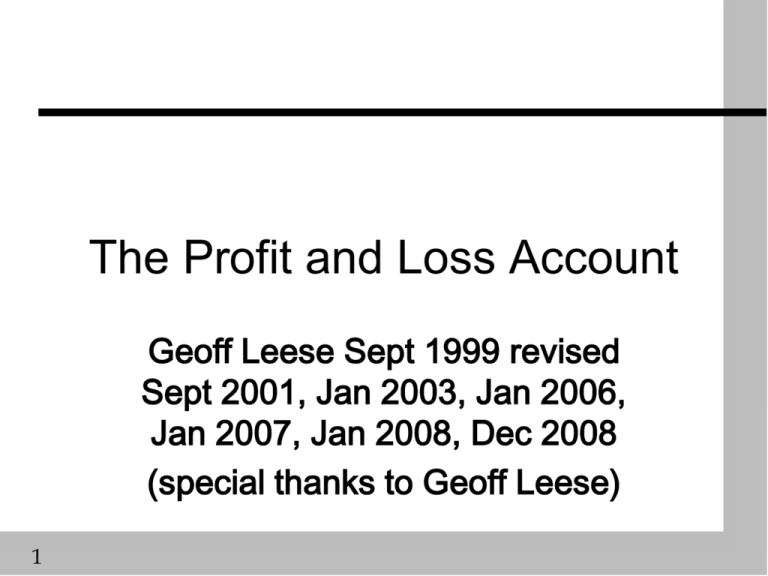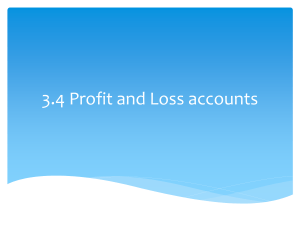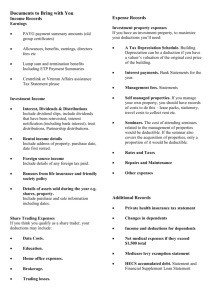Profit and loss account
advertisement

The Profit and Loss Account Geoff Leese Sept 1999 revised Sept 2001, Jan 2003, Jan 2006, Jan 2007, Jan 2008, Dec 2008 (special thanks to Geoff Leese) 1 Profit and Loss Account 2 A profit and loss account is a summary of business transactions for a given period - normally 12 months. By deducting total expenditure from total income, it shows on the "bottom line" whether your business made a profit or loss at the end of that period. A profit and loss account is produced primarily for business purposes – to show owners, shareholders or potential investors how the business is performing. But most of the information is also used by the Inland Revenue to work out your tax bill. Trading Account That part of the profit and loss account where the cost of goods sold is compared with the money raised by their sale to arrive at the gross profit This gives a view of the business in terms of sales and viability of profit 3 Retail trading account for Nov £ Sales Opening stock Purchases Less closing stock Cost goods of sold Gross profit 4 £ 50 000 12 000 30 000 42 000 15 000 27 000 23 000 Yearly Profit and Loss 5 By law, if your business is a limited company or a partnership whose members are limited companies, you must produce a profit and loss account for each financial year Self employed sole traders and most partnerships don’t need to create a formal profit and loss account the information they complete on the self assessment tax return form amounts to the same thing However, there are key benefits to producing formal accounts. If you are looking to grow your business, or need a loan or mortgage, for example, most institutions will ask to see three years’ accounts Keeping accurate records By law business must keep accurate records of income and expenditure. Keep self-employment records for five years and limited company/partnership records for six years after the latest date your tax return is due Accurate record keeping has important benefits. It: 6 gives information to manage your business and make it grow enables reporting on profit/loss easily and quickly when required will improve your chances of getting a loan or mortgage makes filling in your tax return easier and quicker helps you or your company avoid paying too much tax provides back-up for claims for certain allowances helps you plan and budget for tax payments prevents interest or penalties for late tax payments helps reduce accountant fees - your annual accounts will be far easier to produce The basic records you will need to keep are: 7 a list of all your sales and other income a list of all your expenditure, including day-to-day expenses and equipment a separate list for petty cash expenditure if relevant a record of goods taken for personal use and payments to the business for these for limited companies: a record of money taken out for personal use or paid in from personal funds back-up documents for all of the above You will need the information above to create your profit and loss account The Profit and Loss Account The profit and loss statement shows the trading performance of the business and the distribution of profit. Profit is not equivalent to cash in bank Income Customer sales, profit/loss from sale of tangible fixed assets, “non operating” income, investment income Expenses Variable (direct) costs, Fixed (overhead) costs, interest paid, depreciation allowance on tangible fixed assets Distribution Drawings/dividends, retained profit 8 Profit and Loss account Measuring profit Income Expenses The profit and loss statement shows the trading performance of the business and the distribution of profit. Increase in assets 9 Net Profit Drawings or dividends Retained profit Or measuring loss Turnover Costs Net Loss Drawings or dividends Decrease in assets 10 Retained loss SIMPLE COMPANY LTD - Profit and loss account for year ending 31.12.08 £ Turnover Cost of sales (Direct costs) Gross profit Expenses (Overheads) Other Costs (Depreciation) Operating profit Non-operating income Interest payable Profit on ordinary activities before taxation/Net profit Corporation tax Profit after tax Dividends Retained profit for the period 11 950,000 525,000 425,000 Trading account 325,000 10,000 90,000 24,000 15,000 Profit and Loss 99,000 Account 22,500 76,500 30,000 46,500 Appropriation Account Cost of sales (Direct costs) £ Production wages Material costs Opening stock 01.01.08 Plus purchases during the year Less closing stock 31.12.08 Cost of Sales 12 £ 110,000 110,000 500,000 610,000 195,000 415,000 415,000 525,000 Expenses (overheads) £ Wages and salaries (admin) 140,500 Heating and lighting 35,500 Rent and rates 40,000 Telephone 10,000 Advertising 16,000 Car expenses 42,000 Printing and stationery 17,000 Accountant fee 5,000 Insurances 10,000 Provision for bad debts 9,000 £ 325,000 Other Costs Depreciation 10,000 335,000 13 Depreciation Fixed assets such as cars, computers, and machinery are not treated the same as other expenses. Instead of being offset against revenue in the year of purchase, a proportion of the purchase value is allowed as an expense each year over the life of the asset. At the end of the useful life of the asset, it is disposed of (scrapped or sold) and added into the P&L account as non operating income Typical example Computer £ 1100, life of 3 years, expected to make £50 at disposal Depreciation (£1100-£50)/3 = £350 per year 14 Interest and charges £ Non-operating income Interest on bank accounts Other investment income Interest payable 15 24,000 0 24,000 £ Loan interest Overdraft charges 12,000 3,000 15,000 Simple Home Trader P&L Account for year ending March 31st 2008 Consultancy fees Overheads Depreciation £2150 Overdraft cost £80 Car expenses £1500 Other transport £550 Telephone £430 Stationary £700 Insurance £350 Net Profit Drawings Net profit retained in business 16 £17,700 £5,760 £11,940 £7,000 £4,940 Taxable amount for inland revenue returns Financial Ratios (Profitability) Monitoring direct costs (manufacturing companies) Gross profit margin = Gross profit / sales Cost of materials (%) = materials costs / sales Cost of labour (%) = labour costs / sales Monitoring overhead costs Net profit margin = Net profit / sales Overhead cost (%) = Overhead costs / sales 17 Simple Company Limited profit ratio analysis 18 Turnover Cost of sales (Direct costs) Gross profit Expenses (Overheads) Other Costs (Depreciation) Operating profit Non-operating income Interest payable Profit on ordinary activities before taxation/Net profit Corporation tax Profit after tax Dividends Retained profit for the period Gross profit margin Overhead cost Net profit margin Year 525,000 10,000 99,000 46,500 34.2% 2008 2007 950,000 500,000 425,000 325,000 12,000 90,000 24,000 15,000 800,000 450,000 300,000 200,000 15,000 88,000 20,000 16,000 92,000 22,500 76,500 30,000 44,000 88,000 20,000 72,000 28,000 40,000 44.7% 25% 10.4% 37.5% 21.4% 11.5% 2006 700,000 250,000 150,000 85,000 20,000 17,000 18,000 70,000 30,000 35.7% 12.6% Further Reading Dyson, J.R. (2001); Accounting for Non-accounting Students (5th edn); Prentice-Hall (other editions exist) Chapter 3 (Covers book-keeping) Chapter 4 (Covers Profit and Loss and Balance Sheet) Chapter 5 (Covers adjustments) Chapter 6 (covers all of these in a company context) A substantial amount of reading – some 100 pages in all. But necessary. 19



